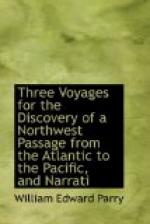We pursued our journey at half past nine P.M., with the wind at N.E., and thick weather, the ice being so much in motion as to make it very dangerous to cross in loaded boats, the masses being all very small. On this account we halted at midnight, having waded three quarters of a mile through water from two to five inches deep upon the ice. The thermometer was at 33 deg.
At seven A.M. on the 28th, we came to a floe covered with high and rugged hummocks, which opposed a formidable obstacle to our progress, occurring in two or three successive tiers, so that we had no sooner crossed one than another presented itself. Over one of these we hauled the boats with extreme difficulty by a “standing pull,” and the weather being then so thick that we could see no pass across the next tier, we were obliged to stop at nine A.M. While performing this laborious work, which required the boats to be got up and down places almost perpendicular, James Parker, my coxswain, received a severe contusion in his back, by the boat falling upon him from a hummock, and the boats were constantly subject to very heavy blows, but sustained no damage.[021] The weather continued very foggy during the day, but a small lane of water opening out at no great distance from the margin of the floe, we launched the boats at eight in the evening among loose drift-ice, and, after some time, landed on a small floe to the eastward, the only one in sight, with the hope of its leading to the northward. It proved so rugged that we were obliged to make three, and sometimes four journeys with the boats and provisions, and this by a very circuitous route; so that the road, by which we made a mile of northing, was full a mile and a half in length, and over this we had to travel at least five, and sometimes seven times. Thus,




